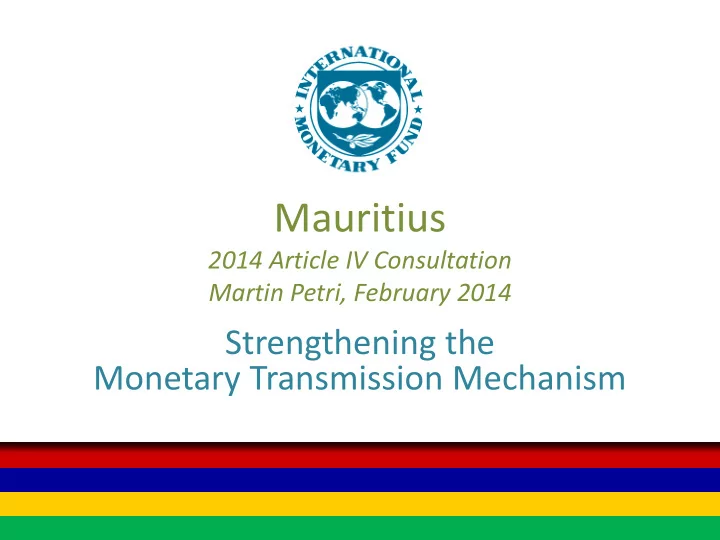

Mauritius 2014 Article IV Consultation Martin Petri, February 2014 Strengthening the Monetary Transmission Mechanism
Summary and Outline Key repo rate (KRR) pass-through to lending works Pass-through to interbank rate (IR) is not effective Excess liquidity causes the disconnect Excess liquidity has other negative consequences Excess liquidity can be removed with T-bills BOM does not have enough T-bills to remove liquidity BOM would need to pay interest on deposits to share costs Removing excess liquidity is contractionary Using T-bills instead of BOM paper helps T-bill market Moving to formal flexible Inflation Targeting (IT) would improve the effectiveness of monetary policy 2
Economic Outlook For 2014 Growth at 3.7 percent Investment expected around 23 percent of GDP Year-on-year inflation at 4.5 percent, average 3.8% Consolidate budget deficit 4.5 percent of GDP, compared to 4.5% in 2013 but only 2.1% in 2012 Government debt 59.9 percent of GDP at end-2013 External current account deficit 8.7 percent of GDP relative to 9.1% in 2013, but with stable financing Reserves are comfortable at 4.4 months of imports; authorities could continue to build buffers 3
Monetary Transmission Mechanism in Two Steps Step 1: Policy rate pass-through to interest rates Partially effective Step 2: interest rates to inflation and output Depends on structural factors of the economy Will focus on interest rate pass-though Interest rates Policy rate Inflation and Output Other channels? 4
Transmission Mechanism Empirically …describes how monetary policy affects The price level Real variables such as aggregate output and employment Transmission in Mauritius: Tsangarides (2010), VAR model Policy rate has a statistically significant but small impact on CPI inflation Policy rate impact on output is weak Possibly because of many administered prices Results are subject to data and empirical methodology limitations How to improve the monetary transmission mechanism? 5
Interest rate pass-through: Mauritius Policy rate to lending rate pass-through improved over the period BOM Switching from Lombard rate to Key Repo rate Mauritius: Interest Rate Pass-through Estimate (2002M1 - 2011M12) 100% 90% 80% 70% 60% 50% 40% 30% 20% Interest rate pass-though 10% 0% 2002M1 2003M4 2004M7 2005M10 2007M1 2008M4 2009M7 2010M10 Sources: Saborowski and Weber (2013) 6
KRR Pass-Through to Bank Interest Rates Deposit and lending rates appear to respond to policy rate changes… Deposit and Lending Rates 15 Key policy rate But, deposit rates Deposit rate are declining. Lending rate 12 Spreads seem to be increasing. 9 Spreads are related to cash ratio, 6 special banking levy, and excess 3 liquidity 0 Jan-07 Jan-08 Jan-09 Jan-10 Jan-11 Jan-12 Jan-13 7
KRR Pass-Through to Market Interest Rates Banks have excess cash since 2007; Rs 6 billion end-2013. BOM has issued BOM bills and increased cash ratio. There are two transmission mechanisms. Interest Rates Bank Excess Cash Holdings (millon rupees) 15 Key repo rate 30,000 Yield on bills Interbank rate 25,000 12 20,000 9 15,000 10,000 6 5,000 3 0 Jan-07 Nov-07 Aug-08 Jun-09 Apr-10 Jan-11 Nov-11 Sep-12 Jun-13 0 Excess cash holdings Bank cash balance Jan-07 Jan-08 Jan-09 Jan-10 Jan-11 Jan-12 Jan-13 Required cash balance 8
Excess Liquidity and Monetary Policy There is a positive correlation between excess cash and repo/interbank interest rate gap… Excess liquidity is harmful for MP and the financial system Loss of control over monetary transmission mechanism Financial disintermediation because banks do not want deposits Banks have an incentive to engage in potentially risky business Excess Cash Holdings and Interbank Rate Excess Cash Holdings and T-bill Rate 6.0 5.0 repo rate - interbank rate 4.0 4.0 repo rate - t-bill rate 3.0 2.0 2.0 0.0 1.0 0.0 (2.0) (1.0) (4.0) (2.0) (6.0) (3.0) 0 2,000 4,000 6,000 8,000 0 2,000 4,000 6,000 8,000 Bank excess cash holdings (Rs million) Bank excess cash holdings (Rs million) 9
Improving the Transmission Mechanism MOFED issues government paper for MP purposes BOM decides on quantity; MOFED on maturities BOM pays interest on government deposits to share costs Total to be issued around Rs 30 billion (almost 8% GDP) BOM’s balance sheet can support losses Helps develop government securities market One instrument instead of two Banks forced to use interbank market Removing excess liquidity is contractionary Could simultaneously decrease KRR for neutrality Would need to be communicated carefully 10
Moving to Flexible Inflation Targeting (IT) Most requirements for IT are in place Forecasting capacity needs to be improved Objectives could be clarified (medium-term price stability and short-term output stabilization) MP likely more effective with IT than discretion Increased credibility leaves more room for stabilization Decreased inflation risk premia help the overall economy Considerations before moving to flexible IT Choice of inflation target and range Accountability and communications mechanisms Consider medium-term inflation-indexed notes 11
Recommend
More recommend